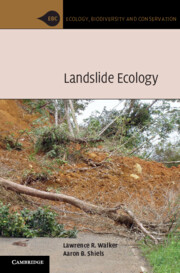Preface
Published online by Cambridge University Press: 05 January 2013
Summary
Landslides are fascinating because they are dangerous and remind us how powerless we are in the face of overwhelming geological forces. Some progress has been made on how to predict their occurrence and how to avoid or reduce the damage that they cause, but humans are still vulnerable to landslides. We find landslides fascinating for another reason. They create a new surface of exposed rock and soil to which plants, animals, and microbes respond. These habitat gaps in the landscape provide great habitats for rock hounds, plant collectors, bird watchers, and other outdoor enthusiasts, in addition to research opportunities for geologists and ecologists. Landslide surfaces are not at all homogeneous, but vary greatly in degree of plant and soil removal, subsequent stability, and soil fertility. Organisms respond to that variability with different patterns of colonization and community development. Understanding these responses can greatly improve landslide stabilization and ecosystem restoration. The new field of landslide ecology examines the biological responses to landslides, including human responses because we avoid, use, cause, and manage landslides. This book synthesizes the growing literature on landslide ecology and provides the first comprehensive examination of landslides as dynamic ecosystems rather than simply as physical phenomena to be predicted, avoided, and mitigated.
We begin this book by emphasizing the relevance of landslides to ecological processes. For instance, landslides act as conduits of soil nutrients and organic matter down slopes and into aquatic habitats including rivers and oceans. Landslides also provide habitats for colonization by early successional species. The spatial complexity of landslides comes both from the contrast with more stable, vegetated surfaces at the undisturbed edge and from variation in fertility and stability along lateral and vertical gradients within a landslide. Such heterogeneity often supports high regional biodiversity. We also discuss the physical causes and consequences of landslides, which is necessary information for any ecological study. These topics have been thoroughly addressed by geomorphologists, so we focus on their potential ecological consequences. For example, post-landslide erosion can reduce rates of ecosystem recovery, which are generally faster in warm, tropical regions than in cooler, temperate ones.
- Type
- Chapter
- Information
- Landslide Ecology , pp. xi - xivPublisher: Cambridge University PressPrint publication year: 2012

